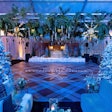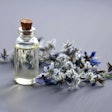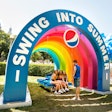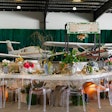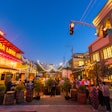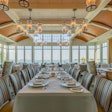In honor of Earth Day, here's a look at new New York restaurants, corporate event venues, hotels, conference centers, and private rooms that factor the environment into their design or operations. Many of these new and renovated New York venues have LEED certification from the U.S. Green Buildings Council or another certification group. They can accommodate groups large or small for private and corporate events, conferences, meetings, weddings, business dinners, teambuilding activities, cocktail parties, and more.
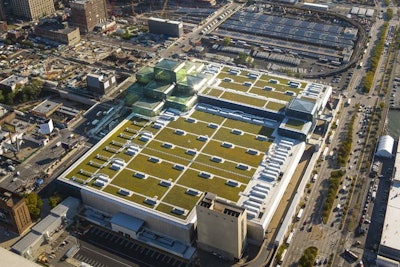
As part of a comprehensive renovation of the Jacob K. Javits Convention Center that finished in 2014, the center added a 6.75-acre green roof designed to reduce storm water runoff (it can collect as much as 6.8 million gallons of water a year). Another benefit to the roof is its role as a habitat for birds: a 2015 ecological study found that 11 bird species use the roof as a habitat. The renovation included other sustainable initiatives such as new energy-efficient mechanical units and lighting that contribute to a 26 percent reduction in the building’s energy consumption. Overall, the convention center has 840,000 square feet of exhibition space, 102 meeting rooms, and four banquet halls.

The Whitney Museum of American Art officially debuts its new downtown location May 1, trading the Upper East Side for the meatpacking district. The 220,000-square-foot contemporary art museum is designed by architect Renzo Piano and will include a 170-seat theater, a black box theater with an adjacent outdoor gallery, and double the exhibition space of its previous home. The museum is seeking LEED Gold certification and incorporated a number of sustainable features such as a cogeneration plant to help the museum reduce its energy cost by 22.2 percent. A green roof, plaza-level planters, and a storm water detention tank reduce storm water runoff, and the museum’s housekeeping plan limits the use of harmful chemicals in the building. During construction, one-fifth of the construction materials were recycled.
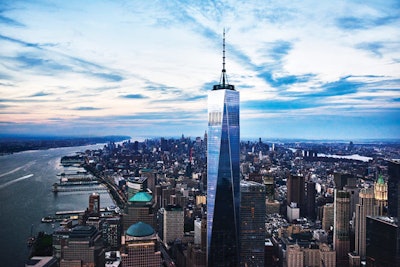
From atop One World Trade Center—the city's tallest building—the One World Observatory will offer panoramic views of New York from levels 100, 101, and 102. The observatory, set to open May 29, is seeking LEED certification for its interior. The entire observatory comprises 120,000 square feet of space. The 102nd floor will serve as a 9,300-square-foot event space that will hold 300 for receptions. It will offer catering and include features such as a sound system and HD projection capabilities. Group rates for admission also are available for groups of 20 or more people.
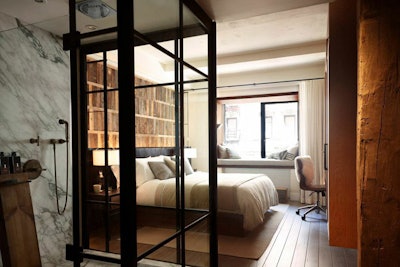
Specifically designed as an eco-friendly hotel brand, 1 Hotel Central Park will make its New York debut this summer. The luxury property, located 58th Street and Sixth Avenue, features interior designs by AvroKo Hospitality that used low-impact, reclaimed, and natural materials. A signature design element from landscape designer Harrison Green of Damien Harrison is a three-story exterior living green wall. The building features energy-efficient heating and cooling systems, low-flow plumbing fixtures, and low-V.O.C paints, adhesives, sealants, and finishes. The property also offers green transportation perks including Tesla electric car service, complimentary bicycle valet, and complimentary parking for guests who bring their own electric vehicles. The property will be home to Jams, chef Jonathan Waxman’s 116-seat restaurant and bar, and have private dining space.

The Sheraton New York Times Square, which debuted a new meeting space in March that caters to smaller groups, has developed green meeting practices such as offering biodegradable or recycled content dinnerware, energy-efficient digital signage, and its “100-mile menu,” which supports farmers within a 100-mile radius who use sustainable farming methods. The hotel also has green design and construction features including a four-pipe HVAC heating and cooling system, energy-efficient lighting, and motion-detection thermostats. The new meeting space, formerly the Executive Conference Center, covers 11,000 square feet on the lower level of the hotel and will be renamed later this spring after a national naming contest for meeting planners. The $2.2 million project refreshed the space’s soft goods, entry lounge, and 13 meeting rooms. Other features include electronic reader boards and a custom boardroom table that is wired for audiovisual hookups. The space is intended for meetings of as many as 150 attendees.
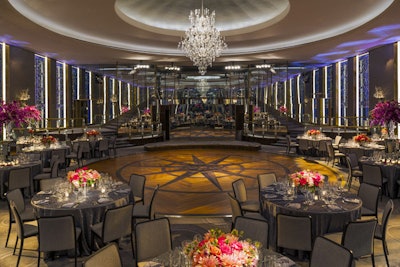
The Rainbow Room, famed for its stunning skyline views from the 65th floor of Rockefeller Center, earned LEED Silver certification in January. The venue, built in 1934, reopened in 2014 after a five-year hiatus. The restored space incorporates sustainability measures such as new Energy Star equipment; low-flow aerators and occupancy water sensors that reduced water consumption by 20 percent; energy-efficient lighting; and a recycling program for paper, cardboard, glass, plastics, and metals. The venue has three spaces for events that can be booked together or separately. The circular Rainbow Room, when combined with the Gallery space, seats 300 guests or holds 250 for dinner with dancing. The chic cocktail lounge SixtyFive seats 92 and attaches to a newly opened terrace.
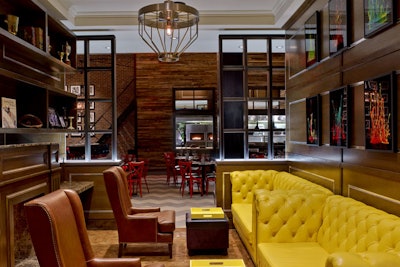
Archer New York, a 180-room hotel in the garment district, is working toward LEED Silver certification. Designed by Glen & Company Architecture, the property worked sustainable initiatives into the design and construction phases as well as its ongoing operations. Examples include energy-efficient heating and cooling systems, a heat and power plant that reduces demand on the electric grid, and an on-site energy recovery unit with an enthalpy wheel used in air ventilation. The hotel also recycled 85 percent of nonhazardous construction waste and debris and used repurposed materials such as wood sourced from a 1770s-era barn in the construction of the on-site restaurant, chef David Burke’s Fabrick. The hotel also offers tours of its facilities and sustainable practices.

Located in Brooklyn’s Prospect Park, the LeFrak Center at Lakeside serves as an ice skating rink in the winter and a roller skating rink in warmer months. The building, designed by architects Tod Williams and Billie Tsien, received LEED Gold certification in September 2014. Among its green building practices are efficient plumbing fixtures that are estimated to save more than 205,000 gallons of water each year, an energy-saving green roof, a cistern that collects rainwater from the roof and irrigates plantings on the green roof, and a storm water runoff system. The center has three private rink-side party rooms that each hold about 40 guests and can be combined; the entire rink is available for buyout.

The Wyndham New Yorker is in the midst of the second phase of a restoration process that has already renovated the Grand Ballroom, other meeting space, and the lobby as well as refreshed many of its 1,024 guest rooms. The Midtown property has a number of eco-friendly practices in place. It purchases energy that was produced by green power—such as solar, hydro, or wind—or buys carbon credits to offset fossil fuel consumption and operates most of its larger air-conditioning motors with variable frequency drives, which allows them to run only as fast as required rather than at full speed. Other initiatives include energy-efficient lighting, low-flow water fixtures, and a solid waste diversion partnership with Great Forest that allowed it to divert 343 tons, or 82 percent of its solid waste stream, away from landfills in 2013. It also donates used soaps, shampoos, and other toiletries to Clean the World, which sterilizes them and distributes them to people in need.

The South of France-inspired bakery Maman, which opened in SoHo in October, has woven a number of eco-friendly practices into its operations. Its food packaging comes from Green Packaging, which specializes in compostable food packaging. Its to-go boxes are made from a variety of surplus agricultural and wildly grown plant fibers such as bulrush, bagasse, bamboo, and wheatstalk. The plants are grown for food and other purposes, with the byproduct used in the tree- and bleach-free packaging. For private events, the space seats 24 or holds 30 for receptions.











